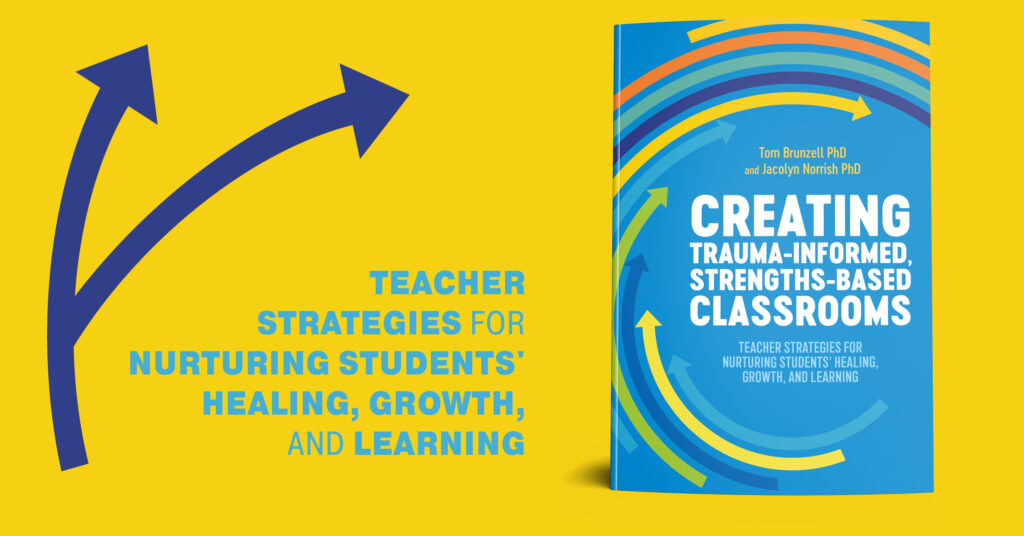
Tom Brunzell and Jacolyn Norrish introduce their new book Creating Trauma-Informed Strengths-Based Classrooms which provides strategies for teachers that integrate the emerging research of trauma-informed education and positive psychology to support all students, with focus on those most vulnerable. It provides practical strategies to increase students’ engagement with learning and with their school communities.
Teachers want the best outcomes for students who struggle to engage with learning, and they need effective strategies to assist students to stay with the task and feel the satisfaction of everyday accomplishment. However, many students continue to struggle in classrooms due to the impacts of chronic stressors in their lives. When students try to meet their own needs in unhealthy ways within the classroom, a need for empowerment can often look like students attempting to control others. A need for safety can look like a student giving up quickly because they’ve frozen up and are not sure how to proactively seek support.
In our work across Australia and overseas, we lead teams to support teachers to learn, integrate and sustain strategies for student engagement. Teachers around the world are becoming aware of trauma-informed education which is applying the knowledge of childhood trauma’s detrimental impacts on a child’s growth, development and learning. They may also have heard about the emergence of positive education, the application of wellbeing science and positive psychology appropriately applied for use in schools.
Our mission is to integrate these two paradigms in a practical way for teachers to enact each day. We understand that in the busy world of teachers, where they are justifiably rationing their time, it can be confusing to want to learn these strategies—but not know how to begin.
What’s wrong with this student?
If you bristled at that sentence, you are not alone! We work with teachers who support students with significant unmet needs when it comes to managing their own behaviour in order to learn and students who desperately require the skills it takes to keep trying even when they feel like giving up. These students have significant needs that initially appear to teachers as deficits. You are not alone if you’ve ever thought:
- This student will not sit still and just can’t focus.
- This student’s reaction goes from 0 – 100 at the smallest problem and then game-over for the rest of the day.
- This student won’t follow his behaviour plan and doesn’t care about the goals.
When teachers come to perceive a student’s behaviour as representing the student’s identity, we know it’s very difficult for a teacher to maintain focus on relationships underpinned with unconditional positive regard or on a proactive mindset to keep supporting the student on a rough day.
Instead, we suggest a shift in our language to describe a student’s struggles by considering their unmet needs and the ways in which they are trying to meet their own needs. When teachers reframe misbehaviour as stressed behaviour a new vista can open a teacher’s own mindset. It’s a more human way to approach our classrooms because all of us act differently under stress. We can begin to position behaviour as a form of communication, and then call on more effective strategies to soothe their central-nervous systems, learn strategies to increase their own self-regulation, help the student stay in ‘thinking-brain’, and eventually assist them to make proactive decisions for themselves.
So instead of focussing on what’s wrong with students, we provide (1) self-regulatory strategies for helping students notice when they feel their own bodies escalating or feel the impacts of stress and uncertainty, and (2) relational strategies for teachers to maintain strong relational bonds with students, particularly when students actively test those bonds as a protective or survival response.
What’s right with this student?
That’s our favourite question! Often, students who struggle can make it difficult for teachers to identify and nurture their strengths. We ask teachers to consider:
- Whenis this student on-task?
- What are the conditions and environmental factors when this student succeeds?
- What are the relational supports that work for this student?
- And what are strategies that students identify work for them to practice their strengths?
In order to shift a teacher’s own mindset to a strengths-based way of supporting students, we invite teachers to begin a journey towards trauma-informed strengths-based classrooms. It takes time and persistence—with a helpful plan inspired by prior teachers who have forged their way towards this goal.
We have seen important shifts in school cultures when all staff members in a school learn how to support the engagement needs of students—and work together to ensure their practice is based on a consistent trauma-informed strengths-based way of encouraging students when they need our support the most.
In addition to meeting students’ unmet needs for self-regulation and relationships, trauma-informed strengths-based teachers have a solid foundation to enact strategies to support students’ stamina for learning, engagement and motivation, and practicing their character strengths each day.
We are excited to share these strategies with you. We want you to learn from our research and practice, and then urge you to consider and adapt our strategies within the cultural contexts of your own school communities and the families you serve. In gratitude, our work acknowledges and builds upon the long lineage of educators collectively working towards educational equity and opportunity for all students—and we invite you to join us!
Tom Brunzell (PhD) is a researcher, program director and education advisor with expertise in school engagement, trauma-informed practices and wellbeing for students and teachers. Jacolyn Norrish (PhD) is a researcher and psychologist with extensive experience implementing wellbeing and mental health initiatives in schools in additional to her role as university lecturer.